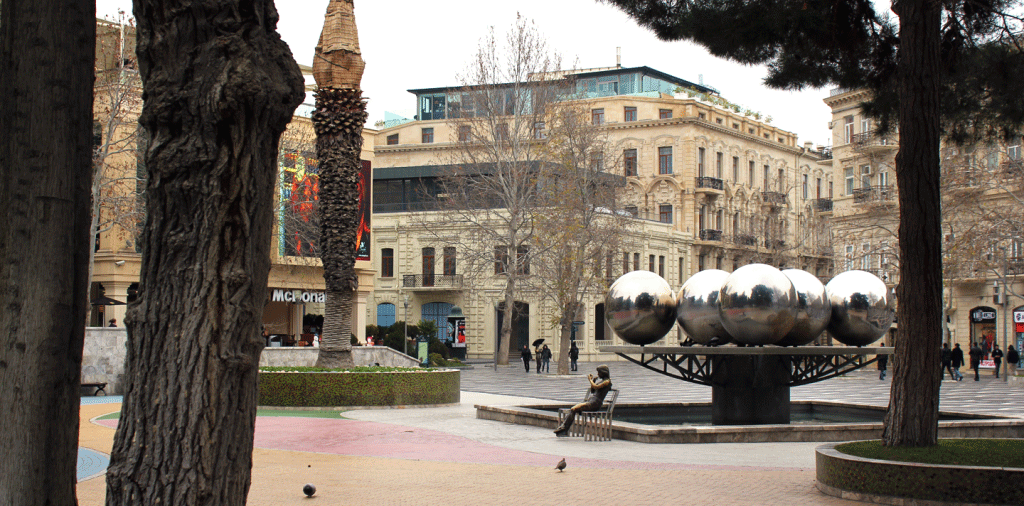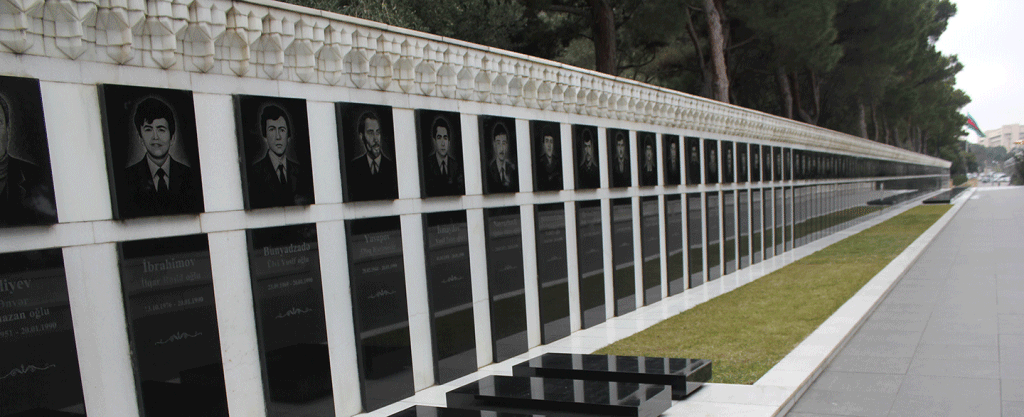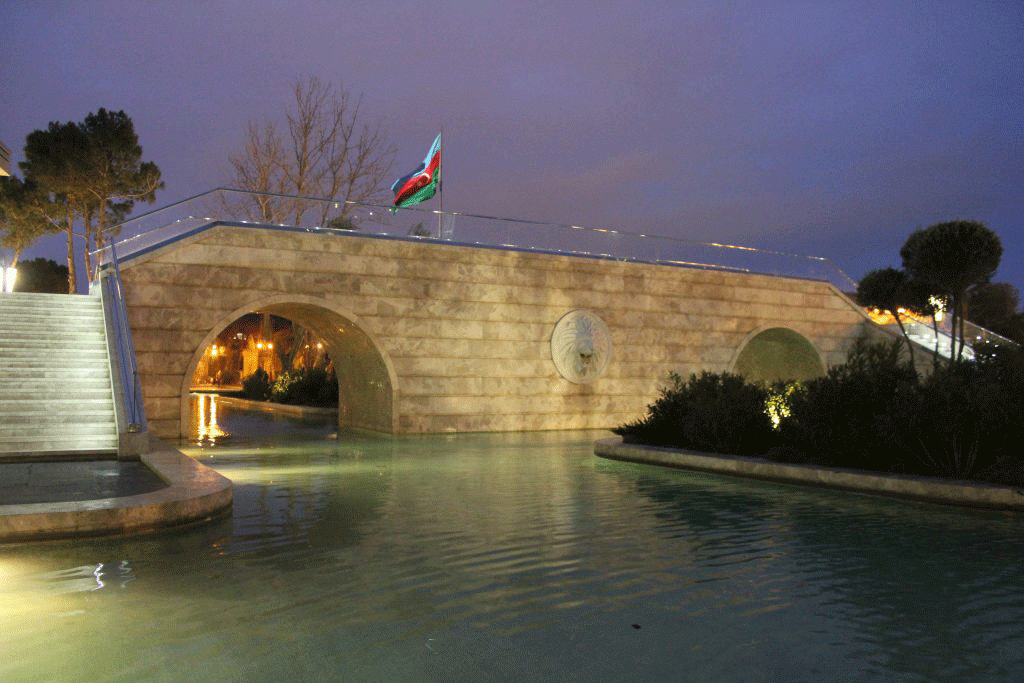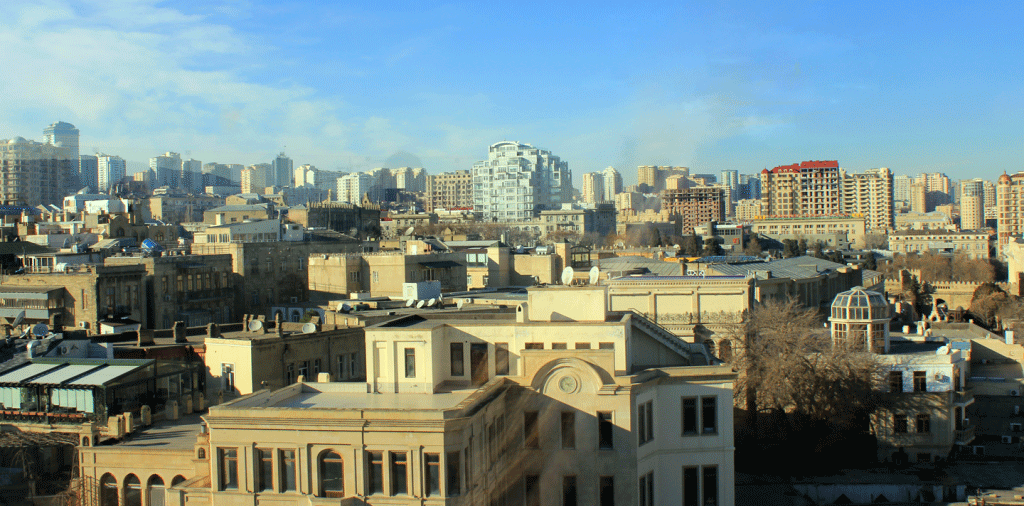
REPUBLIC ERA
Independence from Russia and democracy as a Republic
During the 1960s signs of structural problems in the Soviet system began to appear. Azerbaijan’s crucial oil industry had also lost some of its importance in the Soviet economy. This was partly due to a shift of oil production to other parts of the SSR and also because of the higher costs due to depleted quantities of oil. Ethnic tensions, particularly between Armenians and Azerbaijanis had begun to grow though the Russians managed to suppress the violence.
Early reforms by Heydar Aliyev
In an attempt to end the growing crisis, in 1969, the government in Moscow appointed Heydar Aliyev as the first secretary of the Communist Party of Azerbaijan. Aliyev temporarily improved economic conditions and promoted alternative industries to the declining oil industry. He also consolidated the Republic’s ruling elite, which now consisted almost entirely of ethnic Azerbaijanis. In 1982, Aliyev was made a member of the Communist Party’s Politburo in Moscow; the highest position ever attained by an Azerbaijani in the Soviet Union. However, he was forced to retire by the Soviet leader Mikhail Gorbachev whose policies Aliyev opposed.
Gorbachov Era
The late 1980s, during the Gorbachev era, were characterized by increasing unrest in the Caucasus. This was initially over the Nagorno-Karabakh issue. A political awakening came in February 1988 with the renewal of this conflict. This stemmed from the demand from Armenia to unify Armenia with Azerbaijani territory Nagorno-Karabakh. Though Russia enforced military rule on several occasions, unrest continued to spread.
The ethnic strife revealed the shortcomings of the Communist Party as a champion of national interests. In consequence, independent publications and political organisations began to emerge. Of these organisations, by far the most prominent was the Popular Front of Azerbaijan (PFA). By the fall of 1989 seemed poised to take power from the Communist Party.
As a result of the politics initiated by Mikhail Gorbachev, civil unrest and ethnic strife grew in various regions of the Soviet Union, including the Nagorno-Karabakh region of the Azerbaijan SSR. The disturbances in Azerbaijan, in response to Moscow’s indifference to already heated conflict, resulted in calls for independence and secession. This culminated in Black January in Baku.

Black January
‘Black Saturday’ or the ‘January Massacre’ was a violent crackdown in Baku on January 19–20, 1990, pursuant to a state of emergency during the dissolution of the Soviet Union.
General Secretary of the Soviet Communist Party Mikhail Gorbachev and Defence Minister Dmitry Yazov asserted that military law was necessary to thwart efforts by the Azerbaijani independence movement to overthrow the Soviet Azerbaijani government. According to official estimates between 133 and 137 Azerbaijani civilians died, 800 people were injured and 5 persons went missing. However unofficial sources put the number of victims at 300 dead. Later on, in 1995 Gorbachev apologised to Azerbaijan by stating: “The declaration of a state emergency in Baku was the biggest mistake of my political career”.
In a resolution of January 22, 1990, the Supreme Soviet of Azerbaijan SSR declared that the decree of the Presidium of the Supreme Soviet of the USSR of January 19, used to impose emergency rule in Baku and military deployment, constituted an act of aggression. Despite this, Black January is historically seen as the rebirth of the Azerbaijan Republic.
Events Leading Up to Black January
In December 1989, Azerbaijanis living in regions bordering Iran ripped down border fences, demanding closer ties with ethnic Azerbaijanis living in Iran. The local authorities in Jalilabad surrendered to rioters, turning over administration to the Popular Front of Azerbaijan. This was followed by a non-violent turnover of the Lankaran administration to the Popular Front two weeks later.
On January 9, 1990, the Supreme Soviet of the Armenian SSR voted to include Nagorno-Karabakh in its budget and allowed its inhabitants to vote in Armenian elections, thus disregarding Soviet authority and Azerbaijani jurisdiction and causing rage throughout Azerbaijan. Consequently, this led to demonstrations which demanded the ousting of Azerbaijani communist officials and called for independence from the Soviet Union.
January 20th
Popular Front activists began to set up blockades and take control of regions of Azerbaijan. On January 18, the Popular Front ordered supporters to barricade the main access routes into Baku using hundreds of vehicles. On January 19, 1990 in the late evening 26,000 Soviet troops entered Baku, smashing through the barricades in order to crush the Popular Front.
Mikhail Gorbachev claimed that, gunmen of the Azerbaijani National Front opened fire on the soldiers. However, findings of the Moscow-based non-governmental organisation Shield found no evidence of “armed combatants of Azerbaijani Popular Front”; which was used as a motive to crush the civilian population on January 20.
The troops attacked the protesters, firing into the crowds. This continued for three days the troops acted within the rules of a state of emergency but this state was only disclosed to the Azerbaijani public several hours after the beginning of the offensive, when many citizens already lay dead or wounded in the streets, hospitals and morgues of Baku. During the crackdown, Soviet authorities managed to suppress all efforts to disseminate news from Azerbaijan to the local population and the international community.
Reporting and Legacy of Black January
The Memorial Society and Helsinki Watch reported in May 1991 that they had found compelling evidence that the imposition of the state of emergency had led to an unwarranted breach of civil liberties and that Soviet troops had used unjustified force resulting in many deaths. This includes the usage of armoured vehicles, bayonets and firing on clearly marked ambulances.
The Human Rights Watch report entitled ‘Black January in Azerbaijan’ states: ‘the violence used by the Soviet Army on the night of January 19–20 was so out of proportion to the resistance offered by Azerbaijanis as to constitute an exercise in collective punishment. The punishment inflicted on Baku by Soviet soldiers may have been intended as a warning to nationalists, not only in Azerbaijan, but in the other Republics of the Soviet Union’
Almost the whole population of Baku turned out to bury the dead on the third day, January 22. For another 40 days, the country stayed away from work as a sign of mourning and mass protest.
On February 14, 1992, the Azerbaijani General Prosecutor’s Office instituted a lawsuit targeted at the individuals involved in the massacre. Gorbachev later apologised to Azerbaijan in 1995 by stating: “The declaration of a state emergency in Baku was the biggest mistake of my political career”. In 1994, the National Assembly of Azerbaijan adopted a full political and legal evaluation of the Black January events. According to the decree of the President of Azerbaijan Heydar Aliyev from December 16, 1999, all victims of the crackdown were awarded an honorary title of the “Martyr of January 20” January 20 is marked as Martyrs’ Day (or literally, “the Day of the Nationwide Sorrow”) in Azerbaijan

Nagorno-Karabakh war
The early years of independence were overshadowed by the Nagorno-Karabakh War, which lasted from the late 1980s – May 1994. The conflict took place in the area of Nagorno-Karabakh in southwestern Azerbaijan. It was between ethnic Armenians of Nagorno-Karabakh backed by the Republic of Armenia, and the Republic of Azerbaijan. As the war progressed, Armenia and Azerbaijan, both former Soviet Republics, entangled themselves in a protracted, undeclared war in the mountainous heights of Karabakh. In this war Azerbaijan attempted to curb the secessionist movement in Nagorno-Karabakh.
The demand to unify with Armenia, which began anew in 1988, started in a relatively peaceful manner. However, in the following months, as the Soviet Union’s disintegration neared, it gradually grew into an increasingly violent conflict between Armenians and Azerbaijanis, resulting in claims of ethnic cleansing by both sides. Full-scale fighting erupted in the late winter of 1992. During this time the enclave’s parliament brought about a referendum vote for seperating itself from Azerbaijan and uniting itself with Armenia when Azerbaijan broke from the Soviet Union. This was not officially recognised by Azerbaijani parliament and law and therefore was largely boycotted by the Azerbaijani population of Nagorno-Karabakh. Most of the voters were ethnically Armenien and mostly voted in favour of independence. Despite this vote and the presence of Armenien military throughout and around the area, Nagorno Karrabakh remains internationally recognsised as part of Azerbaijan (by the United Nations).
The Nagorno Karrabakh enclave (renamed by residents as Artsakh) has attempted to fully claim independence from Azerbaijan since 1991. They have developed a parlimetary system in the seperatist enclave with an elected president and unicameal legislature – however remain relient and integrated with Armenia. To date ‘Artsakh’ have not been recognised by any country or international body as its own state, including Armenia.
Mediation and Ceasefire
International mediation by several groups including the Organisation for Security and Co-operation in Europe (OSCE) failed to bring an end resolution that both sides could work with. In the spring of 1993, Armenian forces captured regions outside Nagorno Karabakh itself. This threatened the involvement of other countries in the region.
By the end of the war in 1994, the Armenians were in control of most of the Nagorno Karabakh territory. They also held and controlled 7 districts adjacent to Nagorno Karabakh until 2020. As many as 230,000 Armenians from Azerbaijan and 800,000 Azerbaijanis from Armenia and Karabakh have been displaced as a result of the conflict.
A Russian-brokered ceasefire was signed in May 1994 and peace talks, mediated by the OSCE Minsk Group, were held up until a 7 day war in 2019 when ceasefire was broken. This was eventaully mediated by Russian intervention which maintained a further ceasefire until 12 July 2020 when a new clash was initiated in Agdam, in the Tavuz district of Azerbaijan (outside of the occupied areas of Azerbaijan), along the NorthWest boarder of Azerbaijan and Armenia. This clash between Azerbaijan and Armenia saw four days of military skirmish until a new ceasfire was agreed until 27th September 2020.
Nagorno-Karabakh Military Clashes 2020
(Time of Writing: 30 October 2020)
From 27 September 2020 to the present day the ceasefire between Azerbaijan and Armenia has been predominantly broken. An unconfirmed and daily changing amount of land surrounding the Nagorno Karrabakh area (that have, since 1994 been occupied by Armenian military) have been taken back by Azerbaijani Armed Forces with the intention of removal of Armenian Military from the country.
Internationally there have been calls for a ceasefire from a number of countries as there have been a substantial amount of civillian casulties. Turkey have been open about their political support for Azerbaijan and Armenia has called for support from Russia who they hold a military cooperation with, however Russia has said that they will not support Armenia while they are fighting on a different country’s land. Russia have been active in trying to re-initiate a ceasfire between Armenia and Azerbaijan. The OSCE Minsk Group have not been sucessful to date in maintaining a humanitarian ceasefire despite agreements from both foreign ministers on 10th October 2020.
The link below contains a detailed internal report from Azerbaijan which has been produced in evaluation of civilian loss within the country.
(Warning: contains disturbing and upsetting imagery)
Report on civillian loss for the first 30 days of conflict
Independence and Mutalibov presidency (1991-1992)
During 1990–1991 Azerbaijan struggled for independence from the USSR. Finally, the declaration of independence was introduced by President Ayaz Mutalibov on August 30th. On September 8, 1991, the first nationwide presidential elections, in which Mutalibov was the only running candidate, were held in Azerbaijan.
While the elections were not considered to be fair by international standards, Mutalibov formally became the elected president of Azerbaijan. In December 1991 in a nationwide referendum, Azerbaijani voters approved the Declaration of Independence. This was followed closely by the dissolution of the Azerbaijani Communist Party. Despite this, former members including President Ayaz Mutalibov kept their political positions.
Nogorno-Karabakh Conflict
Meanwhile, the conflict over Nagorno Karabakh continued despite the efforts to negotiate a settlement. Early in 1992, a group of Armenians, without the participation of the Azerbaijani population of Karabakh and in violation of the Constitution of Azerbaijan proclaimed an independent republic. In what was now a full-scale war between Armenia and Azerbaijan, the Armenians gained the upper hand, with covert assistance from the Russian Army. Major atrocities were committed during this time such as the Khojaly genocide of Azerbaijanis. There was social uproar over what appeared to be government inaction. Under intense pressure Mutallibov was forced to resign as president.
Deposition of Mutalibov
His failure to build up an adequate army, which could have helped control the Armenia crisis brought down his leadership. Mutallibov had feared a more powerful army might not remain under his control. On May 14 the Supreme Council Of Azerbaijan relieved Mutallibov of any fault in the massacre. However, the following day armed forces led by the Azerbaijan Popular Front took control of the offices of the Parliament of Azerbaijan and deposed Mutallibov, who left for Moscow.
The Supreme Council of Azerbaijan was dissolved. As was the National Assembly Of Azerbaijan that represented the views of the Azerbaijan Popular Front and former communists. Two days later, while Armenian forces took control of further territory, Isa Gambar was elected as Chairman of the National Assembly. He took on the temporary duties of President of Azerbaijan until the national elections due on June 17, 1992.
Elchibey presidency (1992-1993)
On 7 June 1992 Abufaz Elchibey, the leader of the Popular Front of Azerbaijan (PFA) and former dissident and political prisoner was elected the President of Azerbaijan, gaining 54% of votes and becoming Azerbaijan’s first democratically-elected, non-communist president. During the summer of 1992, Elchibey secured the full withdrawal of the Soviet army from Azerbaijan. Azerbaijan became the first and only former Soviet republic (after the Baltic States) free of Soviet military presence.
Nogorno-Karabakh Conflict
However, within a year after his election, President Elchibey came to face the same situation that had led to the downfall of Mutalibov. In June 1992, the Azerbaijani army started a counter-offensive in Nagorno-Karabakh, codenamed ‘Operation Garanboy’ establishing control of over 40% of the region by the fall of 1992 and approaching within 7 kilometres of Shusha. However, as the Azerbaijani offensive pushed further into Karabakh, it became further bogged down in controversy, mismanagement and corruption. This led to unexpectedly heavy Azerbaijani casualties, loss of heavy military equipment, and the campaign ending in failure
The fighting around Nagorno Karabakh steadily turned in favour of the Armenians, who seized around one fifth of Azerbaijan’s territory. This created more than a million internally displaced persons.
As rebellious troops were advancing onto Baku, President Elchibey invited Heydar Aliyev to Baku on 9 June 1993 for negotiations around the crisis. A military rebellion against Abulfaz Elchibey broke out in early June 1993. The Popular Front of Azerbaijan leadership found itself without political support as a result of the war’s setbacks, a steadily deteriorating economy, and opposition from groups led by Heyday Aliyev .
Confidence Referendum and Replacement
In Baku, Aliyev came to power and quickly consolidated his position. A confidence referendum in August deprived Elchibey of his post.
Aliyev quickly took control of the power, becoming the Chairman of the Azerbaijani parliament on 15 June 1993. As a speaker of the parliament he constitutionally assumed presidential powers. He signed the Bishkek Protocol to cease hostilities on the frontline with Armenia. In addition, he further solidified his power by organizing impeachment hearings and holding a national referendum on 29 August 1993, which formally stripped Elchibey of the presidency.
In another national election, on 3 October 1993, Heydar Aliyev, age 70, was elected as President of Azerbaijan.
Heydar Aliyev Presidency (1993-2003)
Former Azerbaijani Leader Heydar Aliyev was voted as president On 3rd October 1993, after a presidential election was held. Aliyev won overwhelmingly with 99% of the votes. By the end of 1996, the position of Heydar Aliyev as the strong leader of Azerbaijan was unquestionable.
As a result of reforms and the signing of the so-called “Contract of The Century” in October 1994 (over the Azeri-Chirag-Guneshli giant oil field) there were increased oil exports to western markets, the economy began improving.
In October 1998, Aliyev was re-elected for a second term. His second term in office was characterised by reforms, increasing oil production and the dominance of British Petroleum as a main foreign oil company in Azerbaijan. In early 1999, a giant Shah Deniz gas field was discovered, making Azerbaijan potentially a major gas exporter. A gas export agreement was signed with Turkey by 2003. Work on a long awaited Baku-Tbilisi-Ceyhan oil pipeline and Baku-Tbilisi-Erzerum gas pipeline started in 2003. The oil pipeline was completed in 2005 alongside the gas pipeline in 2006.
Heydar Aliyev, as a politician that had come out of retirement to run for presidency unfortunately fell ill. In April 2003, collapsed on stage and could not return to public life. By summer 2003 he was placed into intensive care in the United States. He was pronounced dead on December 12, 2003.

Ilham Aliyev presidency (2003)
Heydar’s son, Ilham Aliyev was elected president the same year as his fathers death. Ilham Aliyev was re-elected in 2008 with 87% of the polls, while opposition parties boycotted the elections.
Oil and revolution
By the 19th century, Azerbaijan was by far the front-runner in the world’s oil and gas industry. In 1846 – more than a decade before the Americans made their famous discovery of oil in Pennsylvania – Azerbaijan drilled its first oil well. By the beginning of the 20th century, Azerbaijan was producing more than half of the world’s supply of oil.
British, Belgian, French German, Swiss, Swedish and American investors were well entrenched in Baku by 1900. Notable among these investors are the Rothschild family, John Rockefeller (Standard Oil) and the Nobel brothers. By 1908, the world’s largest kerosene pipeline was built between Baku and Tatumi – stretching 885 kilometres. In 1912, the Rothschild’s had 13 large tankers transporting oil on the Caspian Sea. By 1900, the oil field of Baku were producing almost half of the world’s oil – with over 3,000 oil wells.
During its early Oil Boom, (1885 and 1920), Azerbaijan benefited greatly from the expertise of notable chemists and geologists from Europe and Russia. Furthermore, Baku’s rich oil barons sought out the best advice that the scientific world had to offer. They sought out advice from important figures like German chemist Carl Engler and Russian chemist Dmitry Mendeleyev. As a result, innovative new techniques such as rotary drilling and ‘gaslift’ were tested for the first time in Azerbaijan.
Azeri-Chirag-Guneshli oil field
Formation of the Azeri–Chirag–Gunashli development started in the beginning of 1990s. In June 1991, at the first stage, the consortium started development drilling of the Chirag field. A contract for oil transportation via Russia to the Black Sea port of Novorossiysk was signed on 18 February 1996. The oil transportation through the pipeline started on 25 October 1997
The second stage of the development consisted of the development of the Azerbaijan field. The development of Azerbaijan field started in 2002.The west platform launched in May 2005 and production started in January 2006. The east Azerbaijan drilling modules and quarters arrived in Baku in June 2005. Later, the platform was launched in March 2006. The topside was installed in March 2006 and the production began in October 2006. With 3 stages completed and 7 operational platforms functional, total production from Azeri–Chirag–Gunashli is more than 1 million barrels (160,000 m3) a day.
Shah Deniz gas field
Shah Deniz gas field is the largest natural gas field in Azerbaijan and was discovered in 1999. . It is situated in the South Caspian Sea, off the coast of Azerbaijan, approximately 70 kilometres (43 mi) southeast of Baku, at a depth of 600 metres (2,000 ft.). Overall, the field covers approximately 860 square kilometres (330 sq. mi). Moreover, stretching out over 140 square kilometres, the reservoir is similar in size and shape to Manhattan Island.
It is considered to be a founding link for Southern Gas Corridor aiming to bring additional and alternative natural gas volumes to EU member countries.
The Shah Deniz field is operated by BP which has a share of 28.8%. Other partners include TPAO (19%), SOCAR (16.7%), Petronas(15.5%), LUKoil (10%) and NIOC (10%).
The 692 kilometres (430 mi) South Caucasus Pipeline, which began operation at the end of 2006, transports gas from the Shah Deniz field in the Azerbaijan sector of the Caspian Sea to Turkey, through Georgia.

